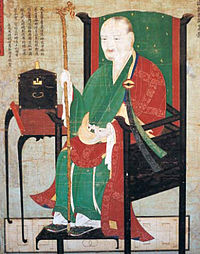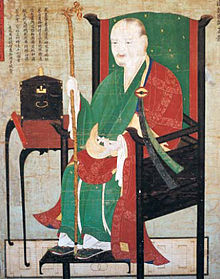| 일 | 월 | 화 | 수 | 목 | 금 | 토 |
|---|---|---|---|---|---|---|
| 1 | 2 | 3 | 4 | 5 | ||
| 6 | 7 | 8 | 9 | 10 | 11 | 12 |
| 13 | 14 | 15 | 16 | 17 | 18 | 19 |
| 20 | 21 | 22 | 23 | 24 | 25 | 26 |
| 27 | 28 | 29 | 30 | 31 |
- 종경록
- 중아함경
- 장아함경
- 대방광불화엄경60권본
- Japan
- 수능엄경
- 마하승기율
- 백유경
- 대승기신론
- 대방광불화엄경
- 가섭결경
- 유가사지론
- 유마힐소설경
- 대반야바라밀다경
- 유마경
- 증일아함경
- 방광반야경
- 근본설일체유부비나야
- 묘법연화경
- 잡아함경
- 금강삼매경론
- 마명
- 마하반야바라밀경
- 정법화경
- 대반열반경
- 원각경
- 무량의경
- 반야심경
- 아미타불
- 대지도론
- Since
- 2551.04.04 00:39
- ™The Realization of The Good & The Right In Wisdom & Nirvāṇa Happiness, 善現智福
- ॐ मणि पद्मे हूँ
불교진리와실천
도선_위키백과스크랩 본문
불기2565-01-13 ~~ 도선 위키백과 스크랩
https://ko.wikipedia.org/wiki/도선
도선
위키백과, 우리 모두의 백과사전.
| 도선 | |
|---|---|
 순천 선암사 선각국사 도선 진영 순천 선암사 선각국사 도선 진영 | |
| 법명 | 도선(道詵) |
| 출생 | 827년 신라 무진주 영암군 |
| 입적 | 898년 신라 무진주 희양현 옥룡사 |
| 종파 | 선종 |
| 출가 | 842년 화엄사 |
| 저작 | 《도선비기》, 《도선답산가》, 《삼각산명당기》, 《송악명당기》, 《옥룡기》 |
| 스승 | 혜철 |
| 제자 | 경보 |
![]() 다른 뜻에 대해서는 도선 (동음이의) 문서를 참조하십시오.
다른 뜻에 대해서는 도선 (동음이의) 문서를 참조하십시오.
| 한국의 불교 |
|---|
 |
| 역사[보이기] |
| 사상[보이기] |
| 인물[보이기] |
| 종파 · 목록[보이기] |
| 대장경 · 소의경전[보이기] |
| 논서 · 주석서[보이기] |
| 사찰[보이기] |
| v t e |
도선(道詵, 827년 ~ 898년)은 신라 말기의 승려이며 풍수설의 대가이다.
기념하여 옥룡사(玉龍寺)에 세운 탑은 증성혜등(證聖慧燈)이라 명명(命名)되었다.
고려 숙종(肅宗, 재위: 1095년 ~ 1105년)은 도선을 대선사(大禪寺)로 추증하고 왕사(王師)의 호를 추가하였다.
고려 인종(仁宗, 재위: 1122년 ~ 1146년)은 도선을 선각국사(先覺國師)로 추봉(追封)하였으며
고려 의종(毅宗, 재위: 1146년 ~ 1170년)은 비를 세웠다.
목차
1생애
2사상
3도선이 등장한 작품
4저서
5같이 보기
6각주
7참고 문헌
생애[■편집]
15세에 승려가 되어 월유산(月遊山) 화엄사(華嚴寺)에서
《대경》(大經)을 공부하여 깨달음을 얻었다.
그 후 수도행각(修道行脚)에 나서서
동리산(棟裏山)의 혜철(惠撤) 대사를 찾아
소위 무설설(無說說) · 무법법(無法法)을 배워 크게 깨닫고,
23세에 천도사(穿道寺)에서 구계(具戒: 불교 의식)를 받았다.
도선은 운봉산에다 굴을 파고 불도를 닦고,
태백산 앞에 움막을 치고 여름을 보내면서 수도생활을 하였다.
마침내 희양현(曦陽縣) 백계산(白鷄山)의 옥룡사(玉龍寺)에 자리 잡고
그곳에서 생을 마칠 목적으로 수양하였다.
신라 헌강왕(憲康王: 재위 875~886)이 그의 명성을 듣고
사람을 보내어 궁중으로 모셔가니
도선은 왕에게 여러 가지 정신적 영향을 주었으나
얼마 후 다시 산으로 돌아왔다.
죽을 때 제자들에게
"인연으로 와서 인연이 다하여 떠나는 것이니 슬퍼하지 말라"라는 말을 남겼다 한다.
효공왕은 요공선사(了空禪師)라는 시호를 내렸고,
제자들이 옥룡사에 징성혜등탑(澄聖慧燈塔)을
세웠다.
고려의 숙종은 대선사(大禪師)를 추증하고 왕사(王師)를 추가하였으며,
인종은 선각국사(先覺國師)로 추봉(追封)하였다. 의종은 비를 세웠다.
사상[■편집]
도선의 음양지리설(陰陽地理說)과 풍수상지법(風水相地法)은
고려 · 조선을 통하여 크게 영향을 준 학설이다.
도선의 사상은 일찍이 고려 태조 왕건(재위: 918년 ~ 943년)의 탄생과 고려의 건설에도 영향을 주었는데,
실제 왕건의 아버지에게 집터를 정해주었다고 전해진다.
도선은 대개 중국에서 기원하여 발달한 참위설을 골자로
지리소왕설 · 산천순역설 및 비보설(裨補說)을 주창하였다.[2]
곧 지리(地理)는 곳에 따라 쇠왕이 있고 순역이 있으므로,
왕처(旺處) · 순처(順處)를 택하여 거주할 것과,
쇠처(衰處) · 역처(逆處)를 인위적으로 비보(裨補: 도와서 더하는 것)할 것을 말하여,
일종의 비기도참서(秘記圖讖書)를 남겼다.[2]
뒷날 고려시대에 성행한 《도선비기》(道詵秘記) 등은
내용 전체가 도선의 문자인지 아닌지는 알 수 없으나,
그의 사상에 연원(淵源)을 받은 것임은 틀림없을 것이다.[2]
하여튼 그의 비기라고 칭하는 예언서가
그의 사후로부터 세상에 유전(流轉)되어 인심을 현혹시킨 일이 많았다.[2]
고려 태조와 같은 이도 도선의 설(說)을 고려하여
자손을 경계하는 훈요십조(訓要十條) 중에서 절을 세우는 데 산수의 순역을 점쳐서
지덕(地德)을 손박(損薄)하지 말 것을 유훈(遺訓)하였다.[2]
도선이 등장한 작품[■편집]
《태조 왕건, KBS, 2000년 ~ 2002년, 배우 : 이대로》
저서[■편집]
풍수지리설과 음양도참설을 기초로 하여 쓰여져 있는 《도선비기》는
고려의 정치 사회면에 큰 영향을 가져왔으며,
민간에 전해지는 저서로는 《도선답산가》(道詵踏山歌),
《삼각산명당기》(三角山明堂記) 등이 있고
그밖에 《송악명당기》(松岳明堂記)·《옥룡기》(玉龍記) 등이 전해지고 있다.
같이 보기[■편집]
풍수
성불사
도선답산가
각주[■편집]
↑ 도선 - 한국학중앙연구원
↑ 이동:가 나 다 라 마 한국사 > 중세사회의 발전 > 고려의 성립 > 호족의 문화 > 풍수지리설, 《글로벌 세계 대백과사전》
참고 문헌[■편집]![]()
![]() 이 문서에는 다음커뮤니케이션(현 카카오)에서
이 문서에는 다음커뮤니케이션(현 카카오)에서
GFDL 또는 CC-SA 라이선스로 배포한 글로벌 세계대백과사전의 "한국사 > 중세사회의 발전 > 고려의 성립 > 호족의 문화 > 도선" 항목을 기초로 작성된 글이 포함되어 있습니다.
| 접기v t e 1996년 선정 이 달의 문화 인물 | |
|---|---|
분류: 신라의 승려
827년 태어남
898년 죽음
풍수
>>>
>>>
https://en.wikipedia.org/wiki/Doseon
[영문위키 번역 with 웨일파파고
( 오류부분은 원문 참조 => 도선_위키백과스크랩 )
https://buddhism007.tistory.com/18001#tao-hsuan-cf
https://buddhism0077.blogspot.com/2021/01/tao-hsuan-cf.html#tao-hsuan-cf
]
도선
무료 백과사전인 위키피디아에서
| 도선 | |
 선암사 도선국사 초상화 선암사 도선국사 초상화 | |
| 한국이름 | |
|---|---|
| 한글 | 도선 국사 |
| 수정 로마자 표기법 | 도선국사 |
| 매쿠네-라이샤워 | 토선국사 |
도선국사는 신라시대의 가장 유명하고 많이 인용된 인물 중 하나로, 한국 역사의 나머지 부분부터 현재까지 매우 영향력 있는 인물로 남아 있다.[1]
내용물
1유아
2초창기 성인 생활2.1여행한다
3만년의 성인 생활3.1풍수설립
3.2점쟁이 설치
4영향
5기말년
6Accolades
7참조
유아[■편집]
도선국사는 월출산 서쪽 경사면에 있는 전라남도 영암군 군섬연지구 구림마을에서 왔다.[2] 도선의 성이 김씨라는 기록은 도선이 신라 태종 무열(664-681)의 차남 후예라는 소문이 있었다는 것을 보여준다.
도선의 어머니는 아름다운 진주(순수한 지혜의 상징)를 삼킨 착상몽을 꾸몄고,
임신 첫 달 동안 불경을 외치며 고기,
양파, 마늘을 항상 기권했다는 전설이 전해진다.
어릴 때부터 도선은 말을 할 수 있게 된 지 얼마 되지 않아
기본적인 수트라의 구호를 배우며 불교의 신동으로 여겨졌다.
도선은 835년 경에 문수암에서 유년기의 일부를 보냈다.
841년 도선은 15세에 영암을 떠나 승려가 되었고,
구례군 화엄사에 유학하였다.
도선은 한 달 만에 '화엄경경의 큰 뜻을 꿰뚫어
문수보살과 보현보살 신비의 문'을 이루었다.
도선은 544년 화엄사를 창건한 명수의 이름인 연이(永i)[1]를 받아 큰 영예를 안았다
.
초창기 성인 생활[■편집]
846년 20세의 나이로 도선은 매우 존경받는 도교 사부로 인정받게 되었다.
그는 혜철 저인선사(惠철을 세운 목사) 밑에서
선(善)을 공부하기 시작했다. 동리산 태안사 수도원.[1]여행한다[■편집]
850년까지 도선은 천도사에서 구족계 자격증을 받고 운봉산 동굴에서 금욕을 실천하고 때로는 태백산 굴에서 여름을 보냈다.
그는 난해한 도이스트와 불교 천문, 점성술, 수학, 지질학(명수), 우주론, 아이칭(주역경) 가르침에 초점을 맞추어
당나라로 가서 더욱 연구하였다.
한국에 돌아오자마자 도선은 한반도 전역에서 위험을 무릅쓰고 지리를 주목하고,
그 독특한 에너지의 근원을 찾았다.
도선은 여행을 마치고 지리산 서쪽에 있는 '볼 언덕'에 산신이 나타나 '풍수지리의 가장 깊은 비밀'을 인류에게 구원을 베푸는 방법'으로 제공했다는 전설이 전해진다.
한국의 풍수 체계/위성은 전적으로 중국 풍수지리학의 연구로부터 온 것이 아니라
한국의 신성한/고전적인 토착민 출신이다.[1]
만년의 성인 생활[■편집]
도선은 광양시 옥룡면지구 옥룡사에서 35년간 교편을 잡고 건립, 정착했다.
헌강왕은 지혜와 통찰력으로 유명한 도선 신라의 승려를 천거했다.[1]
풍수설립[■편집]
도선은 '명수'의 다양한 중국 도이스트 학파를 연구하여 이러한 사상과 원리를 한국의 풍경과 문화 환경에 응용하였다.
그가 설립한 비보풍수지리 제도는 개인의 운명과 인테리어 가구 배치보다는
산과 그 범위, 그리고 지역 사회와 국가 전체에 미치는 정신적 물질적 에너지와
그에 따른 영향에 중점을 둔 '자연과의 조화'에 초점을 맞추고 있다.[3]
도선은 중국의 풍수지리설을
한국의 땅과 기후조건에 적응시키면서
보다 큰 가치를 중시하여 한국 고유의 독특한 형태인 '풍수지리설'[1]을 만들어 낸 천재성 때문에
이러한 영예를 안고 기억되고 있다.
점쟁이 설치[■편집]
도선도 개인과 왕국을 위한 행사의 진로에 대한
앞으로의 변화를 여러 차례 정확하게 예측함으로써
한반도의 지구 에너지 '스핀'인 '백두대간'의 개념을 발전시켰다는 평가를 받고 있다.
도선은 결과적으로 현대 한국 점쟁이들의 창업자-애국 정신의 한 종류로 여겨진다.[1]
영향[■편집]
도선은 고려 태조가 되는 왕건의 가장 영향력 있는 조언자라는 명성의 많은 부분을 얻는다.
875년 송악산에 건설 중인 귀족 저택을 지날 때
도선은 그 터의 웅대한 길흉을 알아보고
2년 안에 아내가 위인으로 성장할 아들을 낳아
한국을 새로운 시대로 이끌 것이라고 젊은 주인에게 말한다.
도선은 밀봉된 봉투에 그 남자에게 서류(도선비기로 추정되는)를 주고,
어린 주인은 그것을 안전하게 지키라는 것과 비밀로 하라고 말하고,
그 서류는 소년이 자랄 때만 주라는 것이다.
젊은 주인은 순종했고, 그곳에서 예언자로 태어난 소년은 그 문서 속의 충고를 따랐고,
새로운 고려 왕조의 건국 왕이 되었다.
도선은 특히 도선비구에 수도를 비롯한 전국의 중요한 도시와 성곽의 위치를 정하고,
지석상서로운 곳에 많은 웅장한 절을 건립하는 데 있어서 중요한 조언과 개념을 남겼다.[1]
기말년[■편집]
기록에 따르면 도선은 898년 백운산 옥룡사에서
많은 제자들 앞에서 연꽃 자리에 앉아 있다가 죽었다고 한다.
효공왕은 도선의 사후 요공선사(본질적 공허 명상사)의 호칭을 그에게 내렸다.
그의 제자들이 옥룡사에 그를 기리기 위해 '징성혜등탑'이라는 탑을 세웠으나,
그 탑은 더 이상 존재하지 않는다.
Accolades[■편집]
고려 숙종은 사후에 도선을 왕사(왕사/왕실 스승)에 추증했다.
또한 인종은 도선을 가장 높은 계급인 국사(국사)로 승격시켜 성악국사라는 이름/제목이 있고,
통용되는 명칭인 도선국사(도선국사)가 있다.
기록에 따르면 의종은 고려의 수도 개성에 도선(道善)[1]에 비석을 세웠다.
참조[■편집]
^ 위로 이동:"san-shin.net". Retrieved 2012-06-16.
^ "visitkorea.or.kr". Retrieved 2012-06-16.
^ "knps.or.k". Retrieved 2012-06-16.
카테고리: 신라 승려

○ 2018_1023_175211_can_ar44 예산 덕숭산 수덕사

○ 2018_1023_145603_can_bw4_s12 예산 덕숭산 수덕사

○ 2018_1022_173326_can_CT27 공주 태화산 마곡사

○ 2018_1022_130700_can_bw4_s12 공주 계룡산 갑사

○ 2020_1017_160803_can_ori_rs 삼각산 화계사

○ 2020_1017_153400_can_Ar37 삼각산 화계사

○ 2020_1017_153333_can_CT27 삼각산 화계사

○ 2020_1017_152124_can_ct30_s12 삼각산 화계사

○ 2020_1002_124029_can_ct8_s12 파주 고령산 보광사

○ 2020_0911_111907_nik_BW25 제천 의림지 대도사

○ 2020_0908_171333_nik_ar3 합천 해인사 백련암

○ 2020_0905_142157_can_BW28 오대산 상원사

○ 2020_0905_130126_nik_BW28 오대산 상원사

○ 2020_0904_135522_nik_BW17 원주 구룡사

○ 2020_0904_090945_nik_BW27 여주 신륵사

○ 2020_0430_124311_can_ab35 종로구 창의문로 성불사

○ 2019_1106_102545_can_Ar26_s12 화순 영구산 운주사

○ 2019_1105_170231_nik_ar45_s12 순천 조계산 송광사

○ 2019_1105_154510_nik_ct9_s12 순천 조계산 송광사

○ 2019_1106_120733_nik_CT33 화순 영구산 운주사
>>>
Doseon
From Wikipedia, the free encyclopedia
| Doseon | |
 Portrait of Doseon Guksa in Seonamsa Temple Portrait of Doseon Guksa in Seonamsa Temple | |
| Korean name | |
|---|---|
| Hangul | 도선 국사 |
| Revised Romanization | Doseon Guksa |
| McCune–Reischauer | Tosǒn Kuksa |
Doseon Guksa remains one of the Silla Dynasty's most well-known and oft cited figures, remaining extremely influential throughout the remainder of Korean history up to the present.[1]
Contents
1Childhood
2Early adult life2.1Travels
3Later adult life3.1Establishes Pungsu
3.2Establishes fortune tellers
4Influences
5Final years
6Accolades
7References
Childhood[■Edit]
Doseon Guksa came from the Gurim Village in Gunseomyeon District of Yeongamgun, Jeollanamdo, on the western slopes of Wolchulsan.[2] Although Doseon's family name was Kim records indicate there was a rumor that Doseon was a descendant of a secondary son of Silla's Great King Taejong Muyeol (664-681). Legend has it Doseon's mother had a conception-dream where she swallowed a beautiful pearl (a symbol of pure wisdom), and during her first month of pregnancy chanted Buddhist scriptures, all the time abstaining from meat, onions and garlic.
From infancy on, Doseon was considered a Buddhist prodigy, learning the chants of basic Sutras soon after he could talk.
Doseon spent part of his childhood, around 835, at Munsuam (Bodhisattva of Wisdom Hermitage)
In 841 Doseon left Yeongam to become a monk at the age of 15, and was accepted to study in Hwaeomsa in Gurye County. Within a month Doseon attained "the ineffable wisdom of Munsubosal and the mystic gate of Bohyeonbosal, penetrating the Great Meaning of the Hwaeomgyeong Sutra". Doseon was awarded a great honor by being given the name "Yeongi", which was the name of the master-monk who founded Hwaeomsa in 544.[1]
Early adult life[■Edit]
In 846 at the age of 20 Doseon became recognized as a highly respected Daoist master. He began studying Seon under the great Master and Sect Founder Hyecheol Jeoginseonsa at Dongnisan Taeansa Monastery.[1]
Travels[■Edit]
By 850 Doseon had received the Gujokgye Certification at Cheondosa, practiced asceticism in a cave of Unbongsan and sometimes spending summers in a grotto on Taebaeksan. He journeyed to Tang China to further study, focusing on esoteric Daoist and Buddhist astronomical, astrological, mathematical, geomantic (Feng Shui), cosmological and I Ching (Juyeokgyeong) teachings.
Upon returning to Korea Doseon ventured throughout the Korean Peninsula, noting the geography, and searching for the source of its unique energies. Ending his travels, Doseon built a small hut to rest and meditate in on "Bowl Hill", in western Jirisan where, legend says, a Sanshin appeared to Doseon and offered the "deepest secrets of Pungsujiri" as another "method by which great Bodhisattvas grant salvation to humankind". The Korean Pungsu (풍수) system/wisdom comes from a sacred/ancient indigenous Korean source, not entirely from the study of Chinese Feng Shui.[1]
Later adult life[■Edit]
Doseon founded, constructed and settled in at Okryongsa in Okryongmyeon District of Gwangyang City where he taught for 35 years. King Heongang proclaimed Doseon Silla's leading Master monk because of his reputation for wisdom and insight.[1]
Establishes Pungsu[■Edit]
Doseon studied the various Chinese Daoist schools of "Feng Shui" and adapted those ideas and principles into the Korean landscape and cultural environment. The "Bibo-pungsu-jiri" system that he established, focuses on "harmony with nature" placing greater emphasis on the spiritual and material energies of mountains and their ranges, and the resultant effects on communities and the nation as a whole, rather than on personal fortunes and interior furniture placement.[3]
Doseon is remembered with such honor because of his genius in adapting the Chinese Feng-shui theories into Korea's, very different, land and climate conditions, while placing emphasis on larger values, thus creating Korea's own unique form, "Pungsu-jiri-seol".[1]
Establishes fortune tellers[■Edit]
Doseon also is considered to have developed the concept of the "Baekdu-daegan", the earth-energy "spine" of the Korean Peninsula, by making many accurate predictions of future changes to the courses of events for individuals and the Kingdom. Doseon is consequently regarded as a kind of founder-patron-spirit of modern Korean fortune tellers.[1]
Influences[■Edit]
Doseon derives much of his renown as the most influential adviser to Wang Geon, who becomes Goryeo's King Taejo. In 875 when passing by an aristocratic mansion under construction at Songaksan, Doseon recognized the grand auspiciousness of the site and tells the young owner that in two years his wife would give birth to a son who would grow to be a great man, leading Korea into a new age. Doseon gives the man a document (believed to be the Doseon-bigi) in a sealed envelope telling the young owner to keep it safe and a secret, to only give it to the boy when he grows up. The young owner complied and the boy born there as prophesied, followed the advice within that document, becoming the founding King of the new Goryeo Dynasty.
Doseon left behind advice and concepts, especially in the Doseon-bigi, that were significant in choosing the placement of the capital and other important cities and fortresses within the country, and in constructing many new grand Buddhist temples at geomagnetically auspicious sites.[1]
Final years[■Edit]
Records indicate that Doseon died in 898 while sitting in the lotus position in front of his many disciples at Baekunsan Okryongsa. Following the death of Doseon, King Hyogong conferred the posthumous title of Yogong Seonsa (Essential Emptiness Meditation Master) upon him. His students erected a pagoda called Jingseonghyedeungtap in his honor at Okryongsa, however the pagoda no longer exists.
Accolades[■Edit]
Goryeo's King Sukjong posthumously promoted Doseon to the rank of Wangsa (Royal Preceptor/Teacher of the King). King Injong further promoted Doseon to the highest possible rank, Guksa (National Master), with the name/title Seongak Guksa and common usage title Doseon Guksa (Tao Abundance National Master).
King Uijong erected a monument to Doseon in Goryeo's capital city of Gaeseong, according to records.[1]
References[■Edit]
^ Jump up to:a b c d e f g h i "san-shin.net". Retrieved 2012-06-16.
^ "visitkorea.or.kr". Retrieved 2012-06-16.
^ "knps.or.k". Retrieved 2012-06-16.
Categories: Silla Buddhist monks
>>>
키워드 연결 페이지
https://buddhism007.tistory.com/5857
○ [pt op tr]







